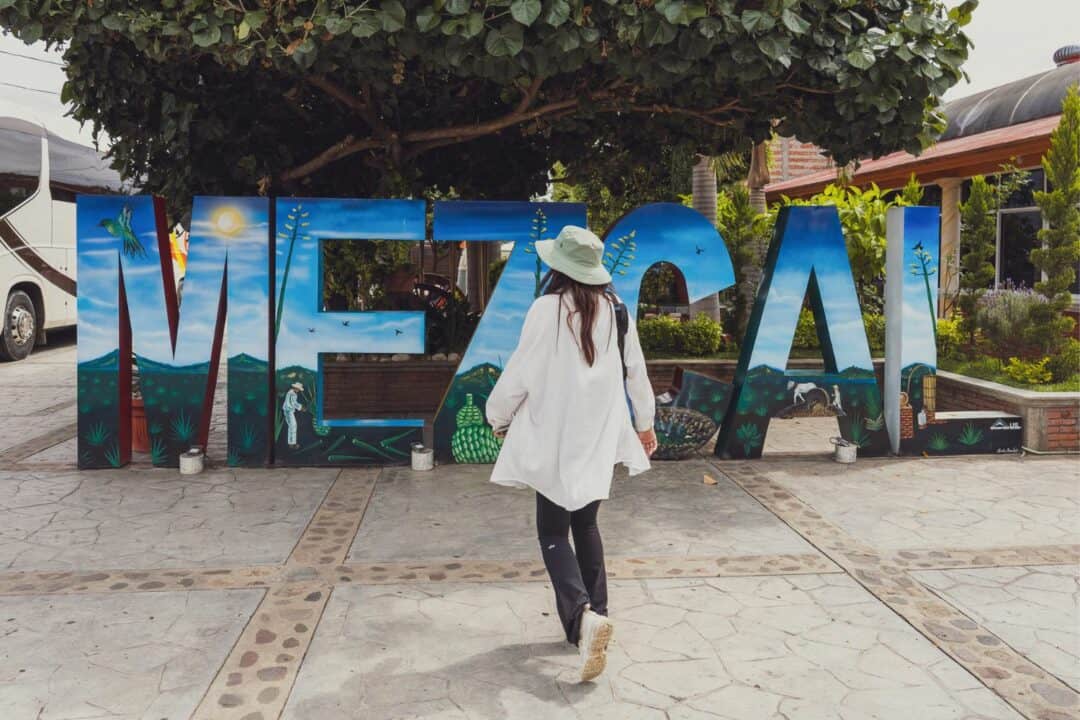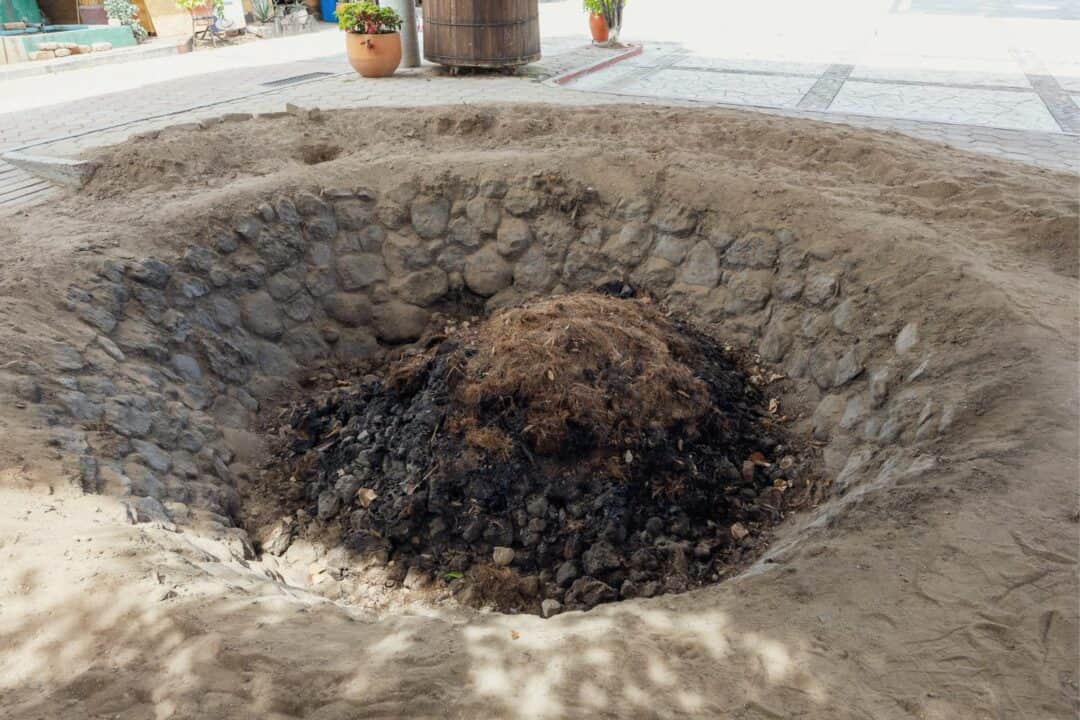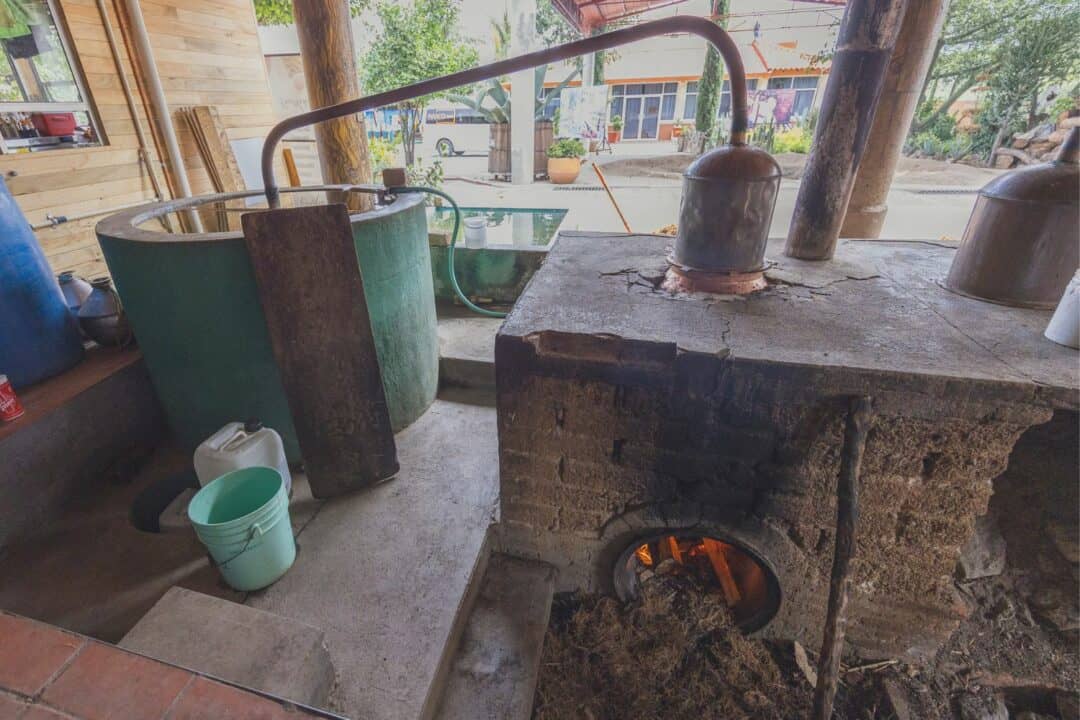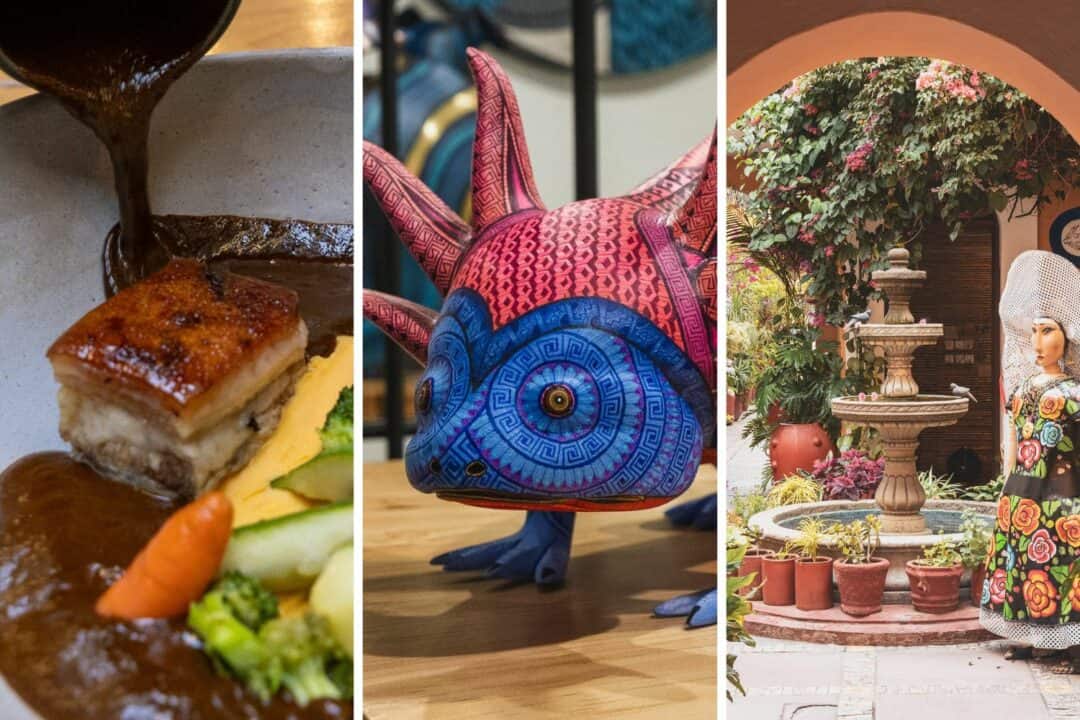Even if spirits aren’t your thing, stepping into a Oaxacan mezcal distillery is quite an experience.
We went on an Oaxacan mezcal tour and learned about the history and cultural significance of mezcal, how it is produced, and of course, had a mezcal tasting experience.
In this article, we’ll tell you all about our experience going on a mezcal tour in Oaxaca – from all the different types of agave, to the traditional production process, to the tasting experience.
We even debunk some common mezcal myths – so be sure to read to the end for that!
What is Mezcal, Anyway?
Mezcal is a distilled alcoholic beverage made from the agave plant.
Oaxaca has a rich mezcal tradition, and over 90% of all mezcal produced is made in the Mexican state of Oaxaca.
But isn’t tequila made from agave too?
That’s correct – but there are a few differences between tequila and mezcal.
Tequila is made strictly from blue agave, whereas mezcal can be made from any type of agave.
Another difference between tequila and mezcal is how they’re made.
While tequila is made by steaming the piñas (hearts) of the agave plants, mezcal is made by roasting the piñas underground. This is what gives mezcal its rich, smoky flavor.
Our Mezcal Distillery Tour
On our way back to Oaxaca City from the Mitla ruins, we ended up driving through some agave fields.
If you’ve never seen the agave fields in Oaxaca, they’re quite sceneic: rolling hills of agave plants that go all the way to the mountains.

Seeing as we just got our first taste of the mezcal process, our next stop was the Mezcal El Rey de Matatlán distillery for a mezcal tour and tasting.
When you arrive at the El Rey de Matatlán distillery, its quite obvious that you’re in the correct place – there’s a giant “MEZCAL” sign at its entrance.

Fortunately, we went there on a pretty slow day. We were able to quickly find a guide that spoke a fair amount of english and he took us on a tour of their distillery.
The tour started off with our guide giving us an overview of the entire traditional mezcal production process:
Agave Selection
The first step was, of course, the agave plant itself. The distillery has a bunch of different types of agave right there in their small garden.

Each variety of agave has a different flavor profile. When all the varieties are sitting right there next to each other, you can really see their difference – not only in their size but in their shapes as well.
The thing that surprised us the most was the lifespan of the agave plants. Some varieties of agave mature in a few years – while others take decades.
Another crazy thing about agave is that some varieties ONLY grow in the wild.
Our guide told us of some agave plants that are only found high up in the mountains. These types of agave are the most highly sought-after, and why some bottles of mezcal can easily go for hundreds (or even thousands) of dollars.
The most common type of agave used in mezcal production is Espadín – some 90% of all mezcal is made from Espadín.
When the agave plant reaches maturity, it is time for harvesting. The plant’s piña (core) is extracted by removing the tall stalk and the long, spiky leaves.
What’s left is the piña, the plant’s inner core that sort of resembles a pineapple.

Roasting
The next step is roasting. The piñas are placed in a large pit with hot stones and covered with agave leaves and dirt.

The roasting process lasts several days and is what gives mezcal its signature smoky flavor.
Crushing

After the roasting is complete comes the crushing process. The crushing of the roasted piñas releases all the juices.
The crushing is traditionally done by a stone wheel pulled by a horse, which is what we found in the factory.
A man chased the horse and the horse started running around in a circle. I’m not sure if that’s the traditional way to crush piñas, but it’s how it’s done around here!
Fermentation
The fermentation step is where the magic starts to happen. The agave juice (known as “mosto”) is transferred into large wooden barrels where it’s combined with yeast to facilitate fermentation.

Fermentation is the longest step of the mezcal making process – it can last several weeks.
The fermenting most is super smelly, so we didn’t dwell near the fermentation barrels for too long.
Distillation
After the mosto ferments, it’s finally distillation time.

Mezcal distillation takes place in large copper stills. The chemistry nerd in me really geeked out on this distillation apparatus. It was definitely much larger than anything I used in college.
A mezcalero carefully watches over the entire distillation process, managing the fire and ensuring that the correct temperature is maintained.
I can only imagine how long distillation takes when you have barrels and barrels of fermented juice to go through. Especially since most mezcals are distilled twice, and some even more, depending on the desired alcohol level and taste profile.
Aging
After distillation comes the aging process.
Aging takes place in wooden barrels, usually white oak from the United States or Canada, depending on what kind of mezcal they’re making.

Mezcals are given different labels based on the time that they’re aged:
- Aged less than 1 year: “resposado” (rested)
- Aged 1 year or more: “añejo” (aged)
- Not aged: “joven” (young)
The aging process imparts a huge flavor profile on the mezcal, so any mezcal worth its weight with have one of these labels on it to let you know how long it was aged.
Bottling
The final step in the mezcal production process is bottling.
It sounds simple – just put it in the bottle, right? But there’s actually a critical step in this process: filtration.
Before bottling, the mezcal is filtered to remove any impurities. In this final step, it may also be slightly diluted to reach the desired alcohol content.
Once it’s put in the bottle, it’s labeled and sent off for distribution into the hands of thirsty drinkers!
Our Mezcal Tasting Experience
After our tour of the distillery and an overview of the entire mezcal-making process, we went right into our favorite part: the mezcal tasting.

Our guide brought out 6 different bottles of various ages and flavor profiles:
- Madrecuishe – Made from agave that takes 14 to 16 years to mature. It has a scent of roasted agave, interspersed with woody undertones, and finishing with mineral accents. Alcohol content of 48% to 50%.
- Tepeztate – Made from wild agave that takes up to 35 years to mature! It has a floral scent, complemented by a menthol taste, blending chocolate and pumpkin nuances. Alcohol content of 50%.
- Añejo Gran Reserva – Made from Espadín Agave. It has sweet scents alongside hints of charred oak, with notes of vanilla. This mezcal ages for eight years in wooden barrels. Alcohol content of 35%.
- Añejo – Made from Espadín Agave. It has a sweet aroma and a dark amber tone. It has a toasted wood flavor, with notes of cinnamon and apple, and a creamy body. Aged in Canadian white oak barrels for a year. Alcohol content of 35%. (This one was my personal favorite)
- Abocado Con Gusano – Made from Espadín Agave. Has a slightly woody aroma, and a bright amber color. When sipping, it has a dry, nutty flavor. Has a few worms inside of the bottle. Alcohol content of 38%.
- Joven – Made from Espadín Agave. Has a smoky aroma and a petrichor taste. Alcohol content of 38%.

We tasted the mezcals, one by one. Funnily enough, we stared with the most expensive bottles and worked our way down to the less expensive ones.
My favorite mezcal in the tasting was the Añejo – it’s sort of a “standard” mezcal that’s recommended to new drinkers of the beverage.
Since this was my first time ever drinking mezcal, I’d say that recommendation was spot-on.
Debunking Myths: The Mezcal “Worm”
Okay, so there’s an old myth out there that the mezcal worm is thought to possess hallucinogenic properties. While that would be awesome, it’s obviously not true.
But still, it does take a special kind of courage to eat the mezcal worm – and we were feeling the courage after a few sips.

We each took a worm and rolled it around in salt and tajin before cheers-ing our worms!
The worm exploded in my mouth as I bit into it. I’m not sure what I was expecting – this is pretty much what I should have expected when eating a larvae.
The real myth out there is that the mezcal worm is a worm, when it’s actually not – it’s the larvae of a moth that lives in agave plants.
It’s kind of like how chapulines are the crickets that hang out in corn plants – Mexicans love to just consume the pests that invade their crops. Pretty genius if you ask me.
Historically, finding a worm in the mezcal was an indication of high proof, as alcohol content above a certain level is needed to preserve the worm in the bottle.
Over time, some producers began intentionally adding a worm to the bottle as a marketing gimmick, leading to the misconception that all mezcals should contain a worm, which is not the case. Most mezcals do not include a worm.
Wrapping Up Our Experience
With mezcal being so intertwined with Oaxacan culture, Its hard to NOT do something in Oaxaca that involves mezcal.
Even though we’re not big drinkers, touring a mezcal distillery was an awesome experience – just being around a distillery really makes you appreciate how much care is put into the process of making an alcoholic beverage.
And mezcal does seem to be something truly unique – it’s crazy how people will hike for miles into the mountains of Oaxaca to find that one wild agave plant to make that perfect bottle of mezcal. Absolutely remarkable.
However, it does make me wonder about the ecological impact of mezcal – with some agave species being rare and sought after, it might only be a matter of time until they’re distilled to extinction.
Anyway, I hope you enjoyed our mezcal distillery tour.
If you’re thinking about going on a mezcal tour, or just want to talk about this fascinating beverage, feel free to drop a comment below!




